ISSN ONLINE(2319-8753)PRINT(2347-6710)
ISSN ONLINE(2319-8753)PRINT(2347-6710)
Deepali Gaikwad1, Kundlik Mali2
|
| Related article at Pubmed, Scholar Google |
Visit for more related articles at International Journal of Innovative Research in Science, Engineering and Technology
Thermal Performance of heat transfer devices can be improved by heat transfer enhancement techniques. In the present study, heat transfer from hot water to cold water by double pipe heat exchanger for plain tube and plain tube with twisted wire brush inserts is experimentally investigated. The horizontal double pipe heat exchanger is made from straight copper tube with inner tube and outer tube diameters of 15 and 25 mm, respectively. The twisted wire brush inserts are fabricated by winding a 0.2 mm diameter of the copper wires over a 2 mm diameter two twisted iron core-rods. The inner convective heat transfer coefficient, friction factor are determined as a function of tube geometry and hot air Reynolds number. Effect of inlet fluid temperature and other relevant parameters on heat transfer characteristics and pressure drop are studied for laminar flow. The convective heat transfer coefficient of double pipe heat exchanger under various operating conditions was determined.
Keywords |
| Twisted wire brush inserts, Heat transfer enhancement, Heat exchanger |
I. INTRODUCTION |
| Horizontal double pipe heat exchanger uses various inserts inside tube so as to enhance heat transfer and hence increase heat transfer coefficient [1, 2, 3]. In this type of heat exchanger the swirl flow is generated as fluid flowing through the plain tube with insert. Due to the presence of swirl flow, the convective heat transfer obtained from the plain tube with insert is higher than that with the plain tube without insert. The inserts have a significant effect on the enhancement of heat transfer; however, the pressure drops also increase too. |
| Several papers have studied and concluded that the insertion of twisted wire brush inserts into a double pipe heat exchanger is an attractive method to improve the convective heat transfer coefficient because it generates a swirl flow, which can induce a tangential flow velocity component and enhance fluid mixing between the duct core and the nearwall region. These type of heat exchangers found their applications in heat recovery processes, air conditioning and refrigeration systems, chemical reactors, and food and dairy processes [2]. |
| The double pipe heat exchanger would normally be used for many continuous systems having small to medium heat duties. However, most of the studies under this category prefer laminar flow because twisted wire brush inserts generates a larger increase in the pressure drop for turbulent flow than that of laminar flow compared to the absence of insets in the tube. |
II. RELATED WORK |
| Paisarn Naphon et al. [1] investigated the heat transfer characteristics and the pressure drop of the horizontal concentric tube with twisted wires brush inserts. The plain tube with full-length twisted wires brush and regularly spaced twisted wires brush with 30 cm spacer length inserts were tested. Cold and hot water were used as working fluids for counter flow configuration, respectively. The effect of twisted wires density, inlet fluid temperature, and relevant parameters on heat transfer characteristics and pressure drop were studied. It was found that the twisted wire brush inserts have a large effect on the enhancement of heat transfer, however, the pressure drops also increase. |
| K.V. Sharma et al. [2] conducted experiments to evaluate heat transfer coefficient and friction factor for flow in a tube and with twisted tape inserts in the transition range of flow with Al2O3 nanofluid. It was found that there is considerable enhancement of convective heat transfer with Al2O3 nanofluids as compared to water. The heat transfer coefficient of nanofluid flowing in a tube with 0.1% volume concentration is 23.7% higher when compared with water at number of 9000. Heat transfer coefficient and pressure drop with nanofluid has been determined with tapes of different twist ratios. A regression equation was developed to estimate the Nusselt number which was valid for both water and nanofluid flowing in circular plain tube and with tape inserts. |
| M.M.K. Bhuiya et al. [4] carried out experimental study on the heat transfer performance and friction factor characteristics in a circular tube using twisted wire brush inserts. The study was conducted for flow in turbulent region. The results indicated that the presence of twisted wire brush inserts led to a large effect on the enhancement of heat transfer with corresponding increase in friction factor for the plain tube. It was also found that there was considerable increase in Nusselt number value with increasing Reynolds number. |
| The objective of present study is to develop a heat transfer augmentation technique that involves use of twisted wire brush inserts as a disturbance in a horizontal concentric tube. To accomplish this, the following objectives were specified: |
| 1. To determine the convective heat transfer coefficient with various flow rates and different temperature fields for air to water horizontal concentric tube heat exchanger experimentally with plain tube and tube with twisted wire brush inserts. |
| 2. To compare the thermal performance of horizontal concentric tube heat exchanger without insert and with twisted wire brush inserts. |
| 3. To compare pressure drop and friction factor with plain tube and tube with wire brush inserts. |
III. EXPERIMENTAL SET-UP |
| The important parts of experimental set-up are blower, the test section containing horizontal concentric copper pipes, hot air tank and cold water tank, rotameter, monoblock pump, whose selection is already discussed in previous section. All these instruments are selected as per the requirements depending upon their measuring range, accuracy and availability in the market. The test section is made up of copper tubes as it has higher thermal conductivity. The proposed experimental set-up is shown in Fig. 1 which is fabricated for hot air to cold water heat exchanger system. |
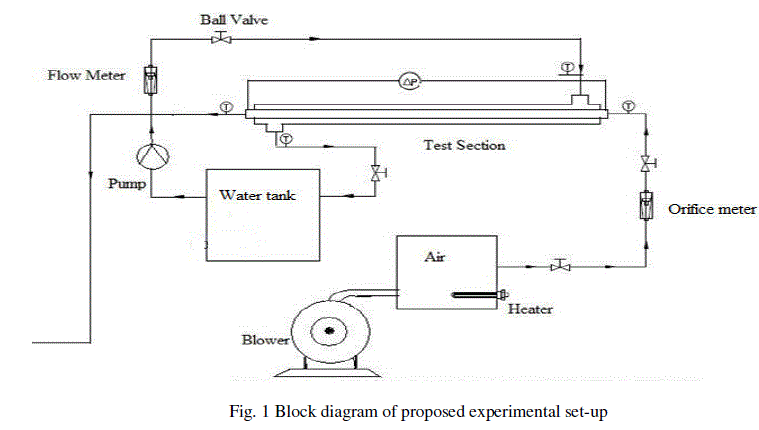 |
| The geometrical configuration and details of the twisted wires brush inserts are shown in Fig. 2. The test section is the horizontal double pipe heat exchanger. It is made from straight copper tube with inner tube and outer tube diameters of 15 mm and 25 mm, respectively. The plain tubes with full-length twisted wires and with regularly spaced twisted wires brush inserts are tested. The twisted wires brush inserts are fabricated by winding 0.2 mm diameter of the copper wires over 2 mm diameter two twisted iron core-rods. |
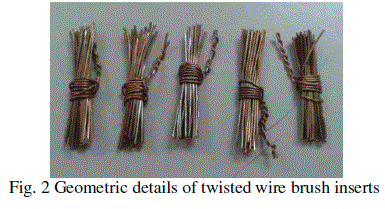 |
| All these instruments are selected as per the requirements depending on their measuring range, accuracy and their availability in the market. The copper tubes are used as it has higher thermal conductivity. The dimensions of pipe are selected according to the experimentation mentioned in the literature. The dimensions of tube and twisted wire brush inserts are kept same for temperature and pressure drop analysis [1]. The thermal performance of heat exchanger is evaluated for laminar flow. The main test section is shown in Fig. 3. Fig.3 Main test section . |
 |
| Two way flow control valves are used to maintain the flow rate of water in outer tube. These valves were selected for half inches piping. Galvanised pipes were used for the tubing connection in set-up. The inlet and outlet temperatures of water in inner and outer tube were measured with PT-100 type of thermocouples located at desired points for temperature measurement. Suitable temperature indicator was selected for this purpose. To determine the pressure drop across the test section, manometer having range 100-0-100 mm was used. Flow control valves were selected for half inches galvanised piping to control the flow rate of water on both hot and cold side. Depending upon the variation of Reynolds number from 800 to 2300, suitable rotameter having a range of 15 to 150 LPH was selected. |
IV. EXPERIMENTAL SET-UP |
| The accuracy of thermocouple and anemometer is given as ±7% and ±5%. The error in readings can be found out by uncertainty and error analysis. The error in heat transfer coefficient and pressure drop are the basic outputs of calculations to be carried out. Heat transfer coefficient (hi) depends upon mass of hot air (mh), mass of cold water (mc), temperature of cold and hot fluid(Tci,Tci, Thi, Tho). Hence the following equation is referred to find out error in calculation heat transfer coefficient. Partial differentiation of this equation will give error in temperatures and mass flow rate. |
| Considering first term of the above function and differentiating, |
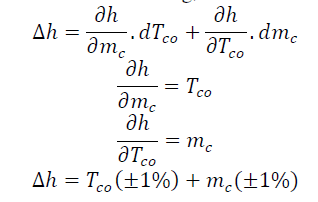 |
| Considering all the terms of the function, |
 |
V. DATA COLLECTION AND ANALYSIS |
| The hot air flows through inner tube and cold water flows through outer tube in a counter flow double pipe heat exchanger. The hot air and cold water inlet-outlet temperatures are taken for various hot air velocities and constant cold water mass flow rates. The observation includes hot air and cold water inlet-outlet temperatures as well as mass flow rates for both cold water and hot air flow rates. Accordingly the result table includes average heat transfer rate, inner tube convective heat transfer coefficient, mass flow rate, velocity, Reynolds number, average inner tube surface temperature, average hot water temperature. Depending upon above results obtained from collected data, various plots are drawn for against Reynolds number and mass flow rates etc and is later discussed in chapter 5. The above study is done for laminar flow regime upto 2300 Reynolds number. Plots for friction factor and pressure drop against Reynolds number and mass flow rates are also presented. |
| The data was collected for plain tube as well tube with twisted wire brush inserts. The different flow rates for cold water and hot water are taken for counter flow heat exchanger. |
| The heat transfer rate for cold water in the test section, Qc, can be expressed as, Qc = mcCpc (Tco- Tci) |
| where, mc is the flow rate of cold water, Cpc is the specific heat of water, Tco and Tci are outlet and inlet cold water temperatures respectively. |
| The heat transfer rate for hot water in the test section, Qh, can be expressed as, Qh = mhCph (Thi– Tho) |
| where, mh is the flow rate of hot water, Cph is the specific heat of water, Tho and Thi are outlet and inlet hot water temperatures respectively. |
| All the fluid thermophysical properties are calculated at the average of inlet and outlet hot fluid temperatures. The average heat transfer rate obtained by is calculated for hot and cold water which is used to calculate the inner convective heat transfer coefficient. The thermal equilibrium test showed that the heat transfer rate on cold side is less than heat transfer rate obtained for hot water. This indicates that there are some heat losses on the outer surface of test section. |
| The average heat transfer rate, Qave is determined as follows, Qave= (Qc + Qh) / 2 |
| This average heat transfer rate can be used to calculate inner convective heat transfer coefficient. In the present study, the tube side heat transfer coefficient for the inner tube can be evaluated from the average heat transfer rate obtained from the equation as follows [1], Qavg= hi Ai (T h,ave– T s,ave) |
| where, T s,ave is the average tube wall temperature, T h,ave is the average hot water temperature, Ai is the inside surface area of the inner tube and hi is the convective heat transfer coefficient of inner tube. The experimental Nusselt number can be calculated from the equation given as below, Nu = hiDi ∕k |
| Also many heat transfer correlations are available in literature review; from this some of the correlations are taken for comparison with available experimental data from present study. Hausen correlation for Nusselt number calculation is proposed for Nusselt number prediction. A number of correlations are developed for laminar flow region, but the one most widely recommended is the Hausen correlation[17] which is taken for reference and is given as, |
 |
| where, Re is hot water Reynolds number, Pr is hot water Prandtl number, di is inner tube diameter, length of inner tube, μi is the fluid viscosity in inner pipe and μw is the wall viscosity of inner pipe. |
| The friction factor correlations can be referred from available literature review, which are as follows [1], f = 0.448 Re-0.275 |
| The above correlation is known as Blasius equation which is the proposed relation to determine friction factor. The experimental correlation for the friction factor is given as, |
| where, l is the length of heat exchanger , dh is the hydraulic diameter, ΔP is pressure drop across heat exchanger, ρ is the density of fluid, v is the velocity of fluid. |
VI. EXPERIMENTAL RESULTS |
| The Fig. 4 represents the performance of concentric pipe heat exchanger with plain tube and tube with twisted wire brush inserts having a plot between tube side Nusselt number and Reynolds number. |
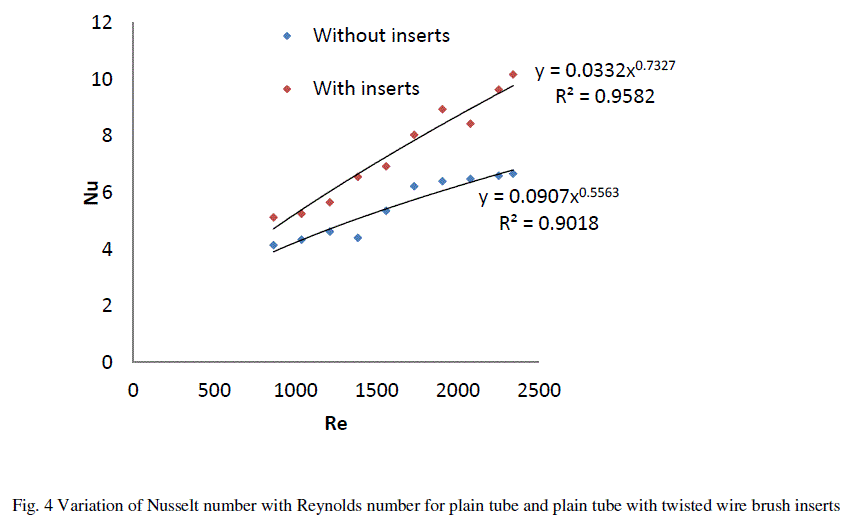 |
| From Fig. 4, it can be observed that there is an increase in Nusselt number value with corresponding increase in Reynolds number. Due to increase in velocity, there is increase in momentum which increases the turbulence and hence enhances the heat transfer capacity. At air side the Nusselt number for tube with twisted tube inserts is higher as compared to plain tube inside Nusselt number value. Due to higher swirl flow generated, the intensity of heat transfer increases. There is approximately 10% increase in Nusselt number for tube with twisted wire brush inserts as compared to plain tube value. |
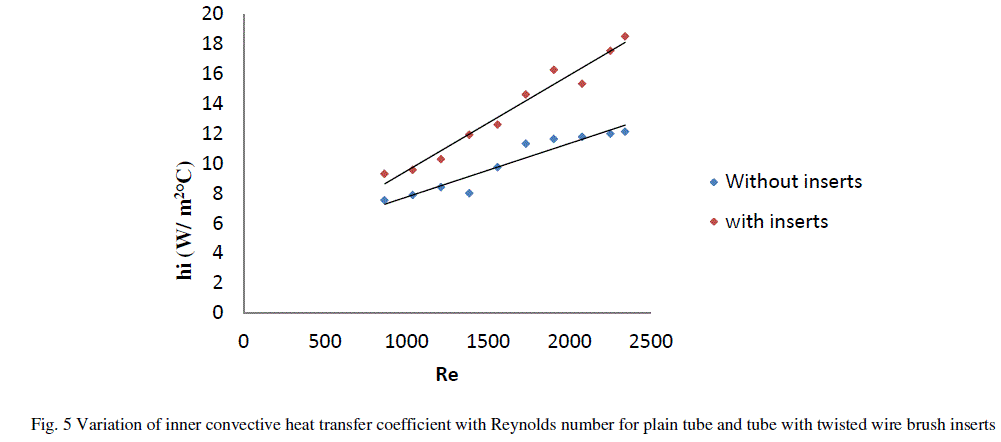 |
| The inner convective heat transfer coefficient on tube side increases with increasing hot water Reynolds number. Approximately there is 10-12% increase in inner convective heat transfer coefficient value for tube with full-length twisted wire brush inserts in comparison to plain tube values. This indicates the corresponding increase in value of Nusselt number values for tube without and with twisted wire brush inserts. |
| The existing correlations available in the literature are available for laminar flow in the horizontal round pipe. Based on experimental investigation and results obtained from it, a correlation was developed between inner tube side Nusselt number and Reynolds number. |
| Nu = a Reb |
| where, a and b are constants and are to be determined. |
| From Fig. 4 Nusselt Number for plain tube is given as |
| Nu = 0.090Re0.556 R2= 0.901 |
| From Fig. 4 Nusselt Number for plain tube with twisted wire brush inserts is given as |
| Nu = 0.033Re0.732 R2= 0.958 |
| The operating range for validity of above correlations is 800<Re<2400.The percentage error of proposed correlation with experimental data was within ± 10 % |
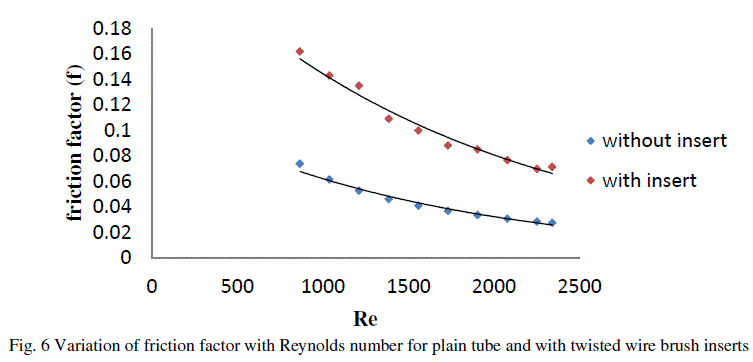 |
| It is clearly observed from fig. 7, that the friction factor continues to decrease with hot water Reynolds number. The flow characteristics through the plain tube with twisted wire brush inserts is quite complicated than plain tube. This friction factor of the plain tube with twisted wire brush inserts is produced due to swirl generated because of inserts, drag forces exerted on the flow field by the twisted wire inserts and turbulence augmentation. As expected the friction factor obtained from plain tube with full length twisted wire brush inserts is higher than plain tube. But the values of friction factor in both the cases are almost close. |
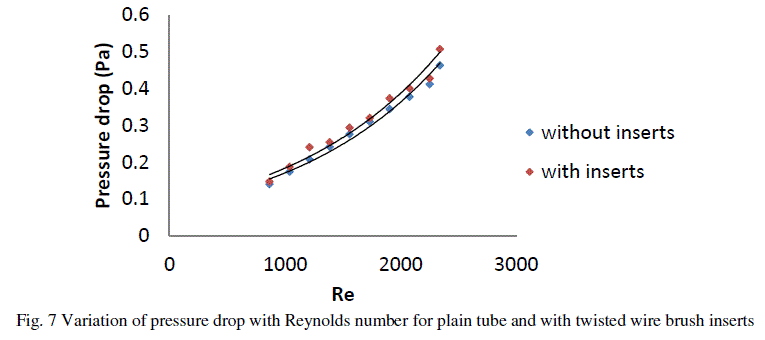 |
| Validation of the experimental results |
| The results obtained from experiments on heat transfer and friction factor characteristics in the concentric plain tube are verified in terms of Nusselt number and friction factor. The Nusselt number and friction factor obtained for plain tube and plain tube with twisted wire brush inserts are compared with those from the proposed correlation by Hausen for determination of Nusselt number. |
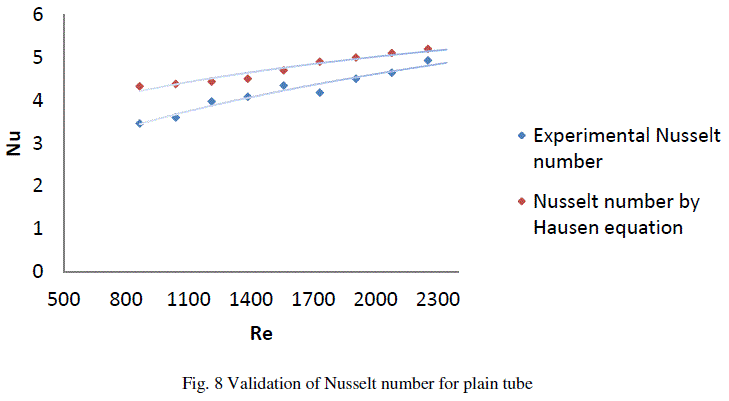 |
VII. CONCLUSION |
| An experimental study was conducted to investigate the heat transfer performance and friction factor characteristics for laminar flow through a tube by means of twisted wire brush inserts. The mass flow rates in inner tube and in annulus were varied during experimentation. Air to water heat transfer study is performed and tested for counter flow configuration. Effect of inlet fluid temperature and relevant parameters on heat transfer characteristics and friction factor are considered. The study revealed that the twisted wire brush inserts provided significant enhancement of heat transfer with the corresponding increase in friction factor, however the pressure drop also slightly increases. Due to the turbulence created and swirl flow generated, the convective heat transfer obtained from the tube with twisted wire brush inserts is higher than that with the plain tube without twisted wire brush inserts. |
| Based on the experimental results, key findings of this study could be summarized as follows: |
| 1. The Nusselt number obtained for the tube with twisted wire brush inserts varied from 1.55 to 2.35 times in comparison to those of the plain tube. |
| 2. The inner convective heat transfer coefficient for twisted wire brush inserts is approximately 9-11 % higher than that for plain tube. |
| 3. The pressure drop for twisted wire brush inserts is 4- 5 % higher than that obtained for plain tube. |
| 4. The variation between theoretical Nusselt number and experimental Nusselt number is approximately 10-15 % because of influence of viscosity effects and the experimental values are in reasonable agreement with predicted values. |
| 5. The friction factor values for twisted wire brush inserts decrease than that for plain tube. It is 7-8% less than that obtained for plain tube. |